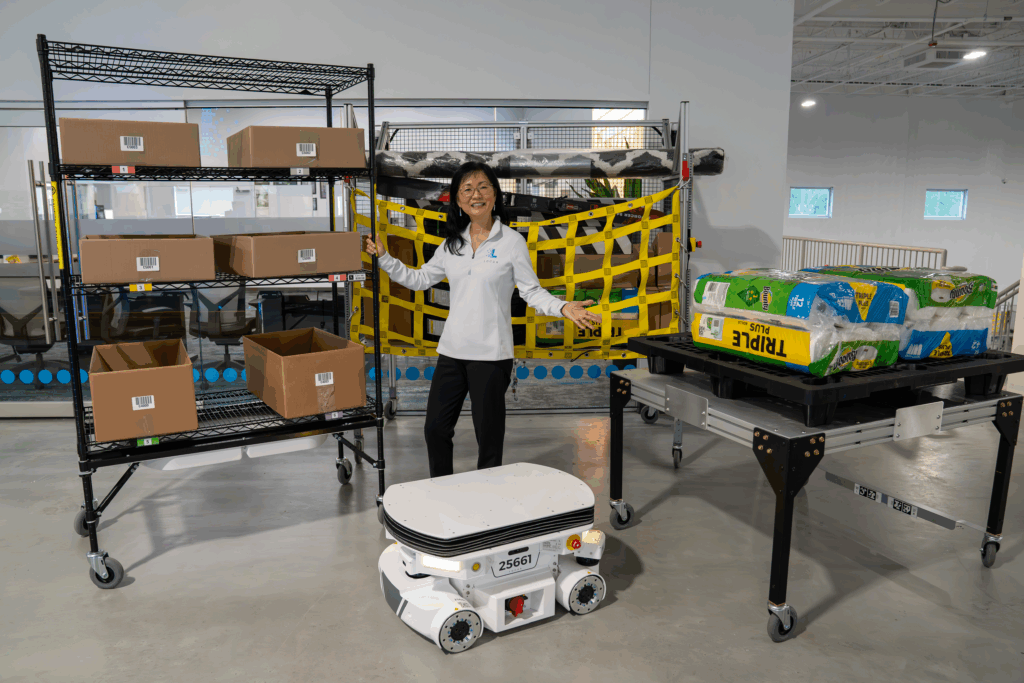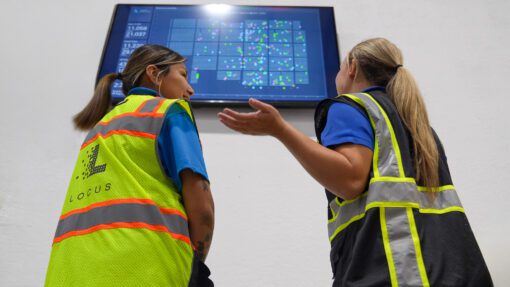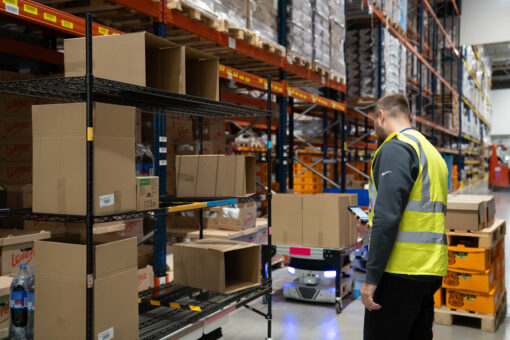WP: How to achieve 400 UPH with Locus Fast Pick
WP: How to achieve 400 UPH with Locus Fast Pick Download Now!
Humans, Warehouse Safety, and the Rise of Robots-to-Goods
Jasmine Lombardi, Chief Customer Officer

Warehouses around the world are facing the same challenge of finding and keeping enough people to keep operations running smoothly. Whether I’m visiting facilities in North America, Europe, Asia-Pacific, or even in regions traditionally considered lower-cost, leaders tell me the same story. There simply aren’t enough people willing to do the work, and the jobs themselves are becoming less attractive to younger generations.
That global reality has accelerated the move toward warehouse automation, not just to save money, but to keep supply chains functioning. Robots bring predictability since they don’t call in sick, they don’t face injury risks due to warehouse safety issues, and they deliver the consistent performance that today’s service level agreements (SLAs) demand. Many executives I speak with admit that if they had to choose between investing a dollar in more human labor or a dollar in automation, they’re increasingly choosing automation.
The Hidden Warehouse Costs of Labor
Labor shortages are one part of the challenge, but the unpredictability of human work brings ripple effects that few leaders account for.
- Injury costs: Pulled muscles, repetitive strain, and collisions with equipment drive up workers’ compensation and insurance.
- Training costs: Many warehouses spend heavily to onboard and train seasonal or temporary staff, particularly in multilingual environments. With our intuitive user interface and language translation, training expenses drop dramatically. Workers can become productive within hours rather than days or weeks to save management both time and budget while improving workforce flexibility. This is especially true with the Robots-to-Goods (R2G) model of Locus Array, which requires little to no training costs.
- Management burden: Warehouses often need more managers just to monitor large seasonal teams.
- Infrastructure strain: During peak, facilities struggle with parking lots full of temporary workers and shuttle buses to transport them to sites.
Robots alleviate and remove these costs, as automation reduces the hidden overhead that comes with running a labor-heavy operation.
Warehouse Safety by Design
Warehouse jobs are some of the most physically demanding roles in the supply chain, and automation directly reduces that risk.
With R2G’s automated picking, fewer warehouse associates are exposed to heavy lifting, pushing carts, or operating large vehicles. In environments that once relied on equipment moving quickly through aisles, accidents and injuries were common. After shifting to robotic workflows, those incidents virtually disappear as warehouses become calmer, safer, and far less stressful for employees.
The same holds true for environmental safety. In some facilities, replacing gas-powered equipment with robots removed exhaust emissions entirely, improved air quality on the floor, and also reduced noise and congestion. Safer conditions mean healthier, more energized associates, and lower costs for the business.
Meeting the Pressure of SLAs
The effect of same- and next-day delivery has reshaped customer expectations with quick delivery no longer being considered a perk but a norm, and the pressure this creates for warehouse operators is constant. Missing a shipment isn’t just a matter of late delivery; it could mean a failed service contract or an impact on someone’s health and wellbeing.
Automation provides the predictability to meet those strict SLAs as robots don’t take unscheduled breaks, miss shifts, or leave a facility shorthanded. That reliability is what allows warehouses to deliver on promises with confidence.
A More Appealing Job
Younger workers are increasingly rejecting warehouse jobs that involve pushing 200-500-pound carts, working long hours on unconditioned floors, or strapping outdated devices to their arms. At the same time, many older workers want to stay active and employed but don't want to risk injury or exhaustion.
Warehouse automation bridges both needs. With hands-free technology, intuitive interfaces, and even gamification features, Locus Robots make the job easier and, in many cases, enjoyable. I’ve seen students say the technology makes summer work “fun,” while older associates are returning to the workforce after robots come in because they no longer need to drive heavy vehicles. The result is a more diverse and engaged workforce.
Retention and Stability
Attracting workers is one challenge, while retaining them is another. High turnover has long plagued warehouses, driving up recruiting and training costs, but automation changes that dynamic.
When robots remove the hardest parts of the job of heavy lifting, the last-minute overtime, and the exhausting repetition, people stay. They have more energy at the end of their shifts, fewer injuries, and greater job satisfaction. I’ve seen operations where turnover dropped to nearly zero after automation was introduced. The benefit isn’t just happier employees; it’s the stability and experience that come with a seasoned workforce.
Training Made Simple
Another overlooked benefit is training time. In multilingual facilities where associates may not share the same language, automation makes onboarding far easier. With intuitive, icon-driven interfaces that can be localized instantly, workers need little more than a short orientation to get started.
I’ve seen brand-new associates intuitively understand how to follow a robot’s instructions. That kind of ease dramatically shortens training cycles and reduces reliance on experienced trainers, making it possible to scale up faster during peak.
Why R2G Is the Next Step
At Locus Robotics, our Robots-to-Goods solution, Locus Array, was created to take on these challenges directly. By automating up to 90% of warehouse tasks, R2G allows operators to maintain throughput without relying on a workforce that is difficult — and in some cases impossible — to hire. This isn’t only about reducing warehouse operating costs; it’s about ensuring orders get out the door, on time, every time.
Consider industries where precision and timeliness aren’t optional. If a shipment for next-day delivery is late or inaccurate, consequences can ripple across hospitals, retailers, or consumers waiting for critical goods. With R2G, operators gain the predictability and accuracy that human-only workflows simply can’t guarantee at scale.
Building a Sustainable Future
For me, the real measure of success isn’t just higher throughput or lower operating costs. It’s walking into a warehouse and seeing associates with more energy at the end of the day. It’s hearing that overtime demands have dropped. It’s knowing that workers feel safer, more valued, and more in control of their time.
Warehouse automation, and especially R2G, is about creating a workplace where safety is the default; operations are predictable, and people can thrive in roles that suit them best. Robots handle the heavy lifting, the dangerous tasks, and the repetitive strain to free humans to focus on higher-value contributions.
That balance is the future of fulfillment — and we’re excited to bring Array to a warehouse like yours.
Ready to explore how R2G and flexible automation can improve safety, retention, and efficiency in your warehouse? Contact us to start the conversation.




